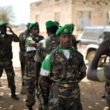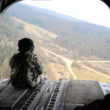Iassume we can defeat Hussein without great cost to our side,” the late columnist Molly Ivins wrote in 2003. “The problem is what happens after we win. The country is 20 percent Kurd, 20 percent Sunni and 60 percent Shiite. Can you say, ‘Horrible three-way civil war?’”
Ivins never considered herself an authority on foreign policy, but one needn’t have been a foreign-policy expert to have anticipated what was coming as the United States geared up for war. The civil war she predicted was underway within four years.
As the neoconservative architects of a foreign-policy disaster of their own creation return to op-ed pages and talk TV, the June 15, 2007, Foreign Relations Committee hearing is worth revisiting.
As the neoconservative architects of a foreign-policy disaster of their own creation return to op-ed pages and talk TV, the June 15, 2007, Foreign Relations Committee hearing is worth revisiting.
Peter Galbraith—a former U.S. ambassador to Croatia and adviser to the government of Iraqi Kurdistan—was one of three witnesses.
Galbraith’s testimony was prefaced by former Indiana Senator Richard Lugar’s remarks:
I outlined what I believe are the United States’ primary strategic objectives in Iraq. And they are: preventing the use of Iraq as a safe haven or training ground for terrorism; preventing civil war and upheaval in Iraq from creating instability that leads to regional war; the overthrow of friendly governments; the destruction of oil facilities or other calamities; and preventing a loss of U.S. credibility in the region and the world. And preventing Iran, finally, from dominating the region.
Not one of the strategic objectives in Lugar’s outline was ever met.
Galbraith described a foreign-policy catastrophe and the tragic and unjustifiable destruction of a country; the toxic politics of Nouri al-Maliki’s government; and the sectarian fault lines that today divide into three countries what in 2003 was Iraq:
The Maliki government is a sectarian Shiite government that is regarded as alien and, indeed, even non-Iraqi by the Sunni Arabs, and as irrelevant by the Kurds. Its conduct— the protection of Shiite militias, its selective provision of government services, the manner in which it carried out Saddam’s execution— provide no evidence that it can transform itself into something different from what it is.
But even if Iraq had a genuine government of national unity, it would be largely irrelevant. There is no part of the country where the government actually exercises significant authority. In the southern half of Iraq and eastern Baghdad, Shiite religious parties have created local theocracies that use militias to enforce a version of Islamic law modeled on Iran but far stricter. The much-vaunted human-rights provisions of the Iraqi constitution do not apply.
Kurdistan in the North is a de facto independent state with its own army and its own flag. The Iraqi Army is barred from the region. Flying the Iraqi flag is prohibited. And central government ministries are not present. Further, the Kurdish people voted 98.5 percent for independence in a non-binding referendum held in January 2005.
The Sunni center is a battleground between insurgents commanding widespread local support and U.S. forces. And Baghdad is the front-line of the Sunni-Shiite civil war.
Galbraith recommended withdrawing U.S. troops and leaving an “over-the-horizon” force in Kurdistan to respond to threats from Al Qaeda.
“The alternative to partition,” he said, “is a continued U.S.-led effort at nation-building that has not worked for the last four years and, in my view, has no prospect for success. That, Mr. Chairman, is a formula for war without an end.”
Galbraith was followed by the American Enterprise Institute’s Fred Kagan, who described a “bifurcation of history in the world” that made U.S. failure in Iraq an existential threat to the United States (although the failure had already come to pass).
The previous week, George W. Bush had adopted recommendations Kagan made in an AEI report, increasing U.S. troop strength in Iraq by 20,000. U.S. fatalities spiked to 970 in 2007 and 832 the following year. Tensions in Iraq decreased but the sectarian civil war never ended.
Today, the AEI website identifies senior fellow Kagan as the “author of the 2007 report Choosing Victory: A Plan for Success in Iraq [and] one of the intellectual architects of the successful ‘surge’ strategy in Iraq.”
Kagan is back, with fellow Iraq War architect William Kristol, urging the president to act “boldly and decisively” and commit more U.S. troops to Iraq.
Lou Dubose is the editor of The Washington Spectator.







0 Comments
Trackbacks/Pingbacks